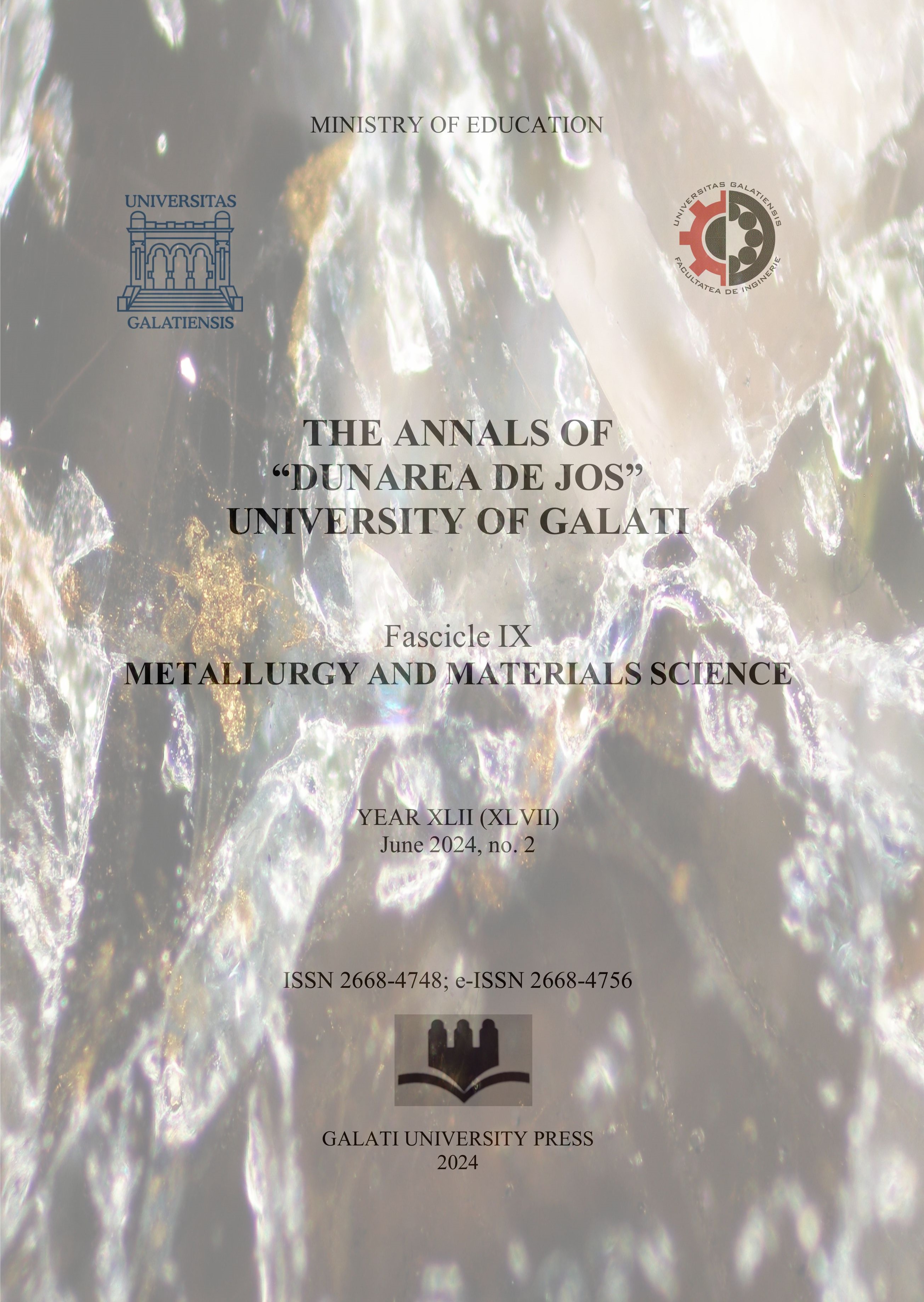The Influence of Chemical Composition on Cobalt-Based Alloys
##plugins.pubIds.doi.readerDisplayName##:
https://doi.org/10.35219/mms.2024.2.05
Résumé
Cobalt-based alloys contain up to 50% cobalt, which means that they provide the material with increased abrasion resistance at high temperatures. Cobalt is similar to nickel because it is a hard material that is very resistant to wear and corrosion, especially at high temperatures. It is generally used as an element in alloys, due to its resistance to corrosion, but also due to its magnetic properties. In all cases, the introduction of an implant into an organism is likely to induce chemical, mechanical, electrical, thermal, magnetic and atomic interactions.
##plugins.generic.usageStats.downloads##
##plugins.generic.usageStats.noStats##
Références
[1]. Henriques B., Silva F., Soares D., J. Mech. Behav. Biomed. Mater., 4, (8), p. 1718-1726, 2011.
[2]. Nowacki J., Pieczonka T., Dilatometric analysis of sintering of iron–boron–cobalt P/M metal matrix composites, Journal of Materials Processing Technology, vol. 157-158, p. 749-754, Achievements in Mechanical and Materials Engineering Conference, 20 December 2004.
[3]. Li W., Lee L. J., Low temperature cure of unsaturated polyester resins with thermoplastic additives: I. Dilatometry and morphology study, Polymer, vol. 41, Issue 2, p. 685-696, January 2000.
[4]. Bobby R. Lanier, et al., Making chromium-cobalt removable partial dentures: A modified technique, The Journal of Prosthetic Dentistry, vol. 25, Issue 2, p. 197-205, 1971.
[5]. Bernhard Wunderlich, Chapter 6 - thermomechanical analysis and dilatometry, Thermal Analysis, p. 311-369, 1990.
[6]. Moon J. H., Won D. M., Analysis of sintering kinetics at different heating rates by dilatometry, Metal Powder Report, vol. 55, Issue 2, p. 39, February 2000.
[7]. Sam Katz, Dilatometry, Methods in Enzymology, vol. 26, p. 395-406, 1972.
[8]. ***, www.academia.edu/4713685/ALIAJE_DENTARE.
[9]. Baba N., et al., Mechanical strength of laser-welded cobaltchromium alloy, J Biomed Mater Res B, 69B, p. 121-124, 2004.
[10]. Bagby M., et al., Metal Ceramic compatibility, J Prosthet Dent. 63, p. 21-25, 1990.
[11]. Behazin M., et al., Combined Effects of pH and γ-Irradiation on the Corrosion of Co-Cr Alloy Stellite-6, Electrochimica Acta, vol. 134, p. 399-410, 2014.
[12]. Baciu E. R., Forna N. C., Influenţa tehnicilor de finisare asupra rugozităţii suprafeţelor componentelor metalice ale restaurărilor protetice, Revista Medico-Chirurgicală a Societăţii de Medici şi Naturalişti din Iaşi, vol. 114, no. 4, ISSN: 0048-7848, p. 1198-2003, 2010.
[13]. Bollen C. M., Lambrechts P., Quirynen M., Comparison of surface roughness of oral hard materials to the threshold surface roughness for bacterial plaque retention: a review of the literature, Dent Mater, 13, p. 258-69, 1997.
[14]. Black J., Hastings G. W., Handbook of Biomaterial Properties, Chapman & Hall, 1998.
[15]. Bezzon O. L., et al., Effect of casting technique on surface roughness and consequent mass loss after polishing of (Ni-Cr) and (Co-Cr) base metal alloys: a comparative study with titanium, J Prosthet Dent, 92, p. 274-279, 2004.
[16]. Bojin D., et al., Microscopie electronică de baleiaj și aplicații, Ed. Agir, București, 2005.
[17]. Barbosa F. O., Araújo M. C., Fractographic Analysis of K3 Nickel-Titanium Rotary Instruments Submitted to Different Modes of Mechanical Loading, Journal of Endodontics, vol. 34, Issue 8, p. 994-998, 2008.
[18]. Black J., Hastings G. W., Handbook of Biomaterial Properties, Chapman & Hall, 1998.
[19]. Baynes J., Domniczak M. K., Medical Biochemistry, St. Louis: Mosby, ISBN 0723430128, 1999.
[2]. Nowacki J., Pieczonka T., Dilatometric analysis of sintering of iron–boron–cobalt P/M metal matrix composites, Journal of Materials Processing Technology, vol. 157-158, p. 749-754, Achievements in Mechanical and Materials Engineering Conference, 20 December 2004.
[3]. Li W., Lee L. J., Low temperature cure of unsaturated polyester resins with thermoplastic additives: I. Dilatometry and morphology study, Polymer, vol. 41, Issue 2, p. 685-696, January 2000.
[4]. Bobby R. Lanier, et al., Making chromium-cobalt removable partial dentures: A modified technique, The Journal of Prosthetic Dentistry, vol. 25, Issue 2, p. 197-205, 1971.
[5]. Bernhard Wunderlich, Chapter 6 - thermomechanical analysis and dilatometry, Thermal Analysis, p. 311-369, 1990.
[6]. Moon J. H., Won D. M., Analysis of sintering kinetics at different heating rates by dilatometry, Metal Powder Report, vol. 55, Issue 2, p. 39, February 2000.
[7]. Sam Katz, Dilatometry, Methods in Enzymology, vol. 26, p. 395-406, 1972.
[8]. ***, www.academia.edu/4713685/ALIAJE_DENTARE.
[9]. Baba N., et al., Mechanical strength of laser-welded cobaltchromium alloy, J Biomed Mater Res B, 69B, p. 121-124, 2004.
[10]. Bagby M., et al., Metal Ceramic compatibility, J Prosthet Dent. 63, p. 21-25, 1990.
[11]. Behazin M., et al., Combined Effects of pH and γ-Irradiation on the Corrosion of Co-Cr Alloy Stellite-6, Electrochimica Acta, vol. 134, p. 399-410, 2014.
[12]. Baciu E. R., Forna N. C., Influenţa tehnicilor de finisare asupra rugozităţii suprafeţelor componentelor metalice ale restaurărilor protetice, Revista Medico-Chirurgicală a Societăţii de Medici şi Naturalişti din Iaşi, vol. 114, no. 4, ISSN: 0048-7848, p. 1198-2003, 2010.
[13]. Bollen C. M., Lambrechts P., Quirynen M., Comparison of surface roughness of oral hard materials to the threshold surface roughness for bacterial plaque retention: a review of the literature, Dent Mater, 13, p. 258-69, 1997.
[14]. Black J., Hastings G. W., Handbook of Biomaterial Properties, Chapman & Hall, 1998.
[15]. Bezzon O. L., et al., Effect of casting technique on surface roughness and consequent mass loss after polishing of (Ni-Cr) and (Co-Cr) base metal alloys: a comparative study with titanium, J Prosthet Dent, 92, p. 274-279, 2004.
[16]. Bojin D., et al., Microscopie electronică de baleiaj și aplicații, Ed. Agir, București, 2005.
[17]. Barbosa F. O., Araújo M. C., Fractographic Analysis of K3 Nickel-Titanium Rotary Instruments Submitted to Different Modes of Mechanical Loading, Journal of Endodontics, vol. 34, Issue 8, p. 994-998, 2008.
[18]. Black J., Hastings G. W., Handbook of Biomaterial Properties, Chapman & Hall, 1998.
[19]. Baynes J., Domniczak M. K., Medical Biochemistry, St. Louis: Mosby, ISBN 0723430128, 1999.
Publiée
2024-06-15
Comment citer
1.
MINCIUNA MG, VIZUREANU P. The Influence of Chemical Composition on Cobalt-Based Alloys. The Annals of “Dunarea de Jos” University of Galati. Fascicle IX, Metallurgy and Materials Science [Internet]. 15juin2024 [cité 16déc.2025];47(2):28-2. Available from: https://gup.ugal.ro/ugaljournals/index.php/mms/article/view/7168
Numéro
Rubrique
Articles



